How To Fish Steelhead With Lures: Advanced Tactics
Welcome to my page on advanced lure fishing methods for steelhead, the full extended article.
Use The Right Lures
Everyone thinks it’s all about having the best lure, but having the best lure is only the first part of lure fishing for Steelhead. One of the most common questions I get asked by anglers and clients who fish lures for steelhead is, “What are the best lures for steelhead?”
The best lures for steelhead are crankbaits, Spoons, spinners, jigs, and plugs in a variety of sizes and colors. The best lures for steelhead will also include lures that go deep, lures that can be fished shallow, lures that can be fished fast, and lures that can be fished slow.
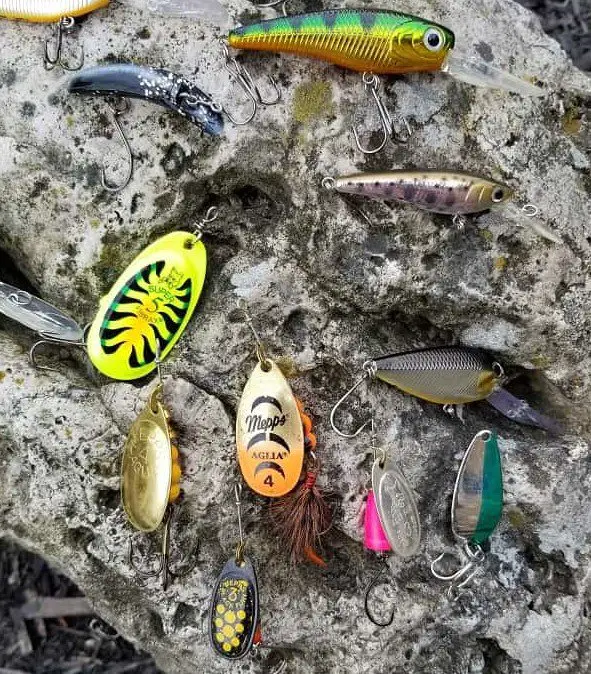
There are other lures that will work for steelhead too, but these 5 lure types will almost always get the job done in any situation.
Even though these steelhead lures are what I would consider the best they are only as good as the guy using them, and they only work well if you know how to fish them properly.
I know you were hoping that I’m going to tell you which lure is my best lure for steelhead, but this page is all about how to fish with lures effectively, and it’s not about my best lure for steelhead.
For more information on my favorite steelhead lures and favorite lure brands, as well as the most effective sizes and colors for steelhead fishing, check out my page Best Lures For Steelhead: A Pro Guides Recommendations
Use The Right Size Lures For Steelhead
One of the first things to consider when lure fishing for steelhead is the size of the lure.
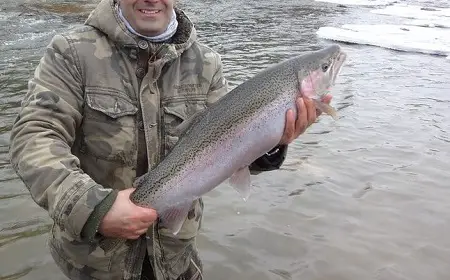
Even very large steelhead will hit a small lure sometimes, but they will likely hit a larger lure more often.
But just because the odd fish will hit a lure that is too big or too small doesn’t mean you can just use any lure for steelhead and expect it to work.
I change my lure sizes based on a number of factors and every day can be different. One day you might catch lots of steelhead on a 3-inch spoon while the next weekend the steelhead won’t touch it.
These are the top things I consider when choosing the right lure size from most important to least important:
- The average size of the fish in the rivers. Bigger fish, bigger lures.
- The fish’s activity level. Active fish, big lures, inactive fish smaller lures.
- The color of the water and the clarity. Most lure sizes are good for clear water. large noisy lures are best in dirtier water.
- Size of the river that I am fishing. Big rivers usually fish best with larger lures of 3 to 6 inches, smaller rivers can be better with 2 to 3-inch lures.
- The water temperature: ideal temps between 48 and 63 larger lures of 3 to 5 inches, ice cold winter fishing is when smaller 2 to 3-inch lures work well.
- The light conditions: bigger lures in low light, smaller to medium-sized lures in bright sun.
This is not an exact science! In very clear water on a bright sunny day and in big water, they might still want bigger lures. That is why I mix it up and try different colors to see what they want.
Use The Right Size Of Lure For The Fish’s Mood
When lure fishing for steelhead I will often start with a smaller lure around 2 to 3 inches, and if that doesn’t work I will start trying larger lures up to 6 inches.
The reason I start with smaller lures is that it’s less likely to spook a nervous trout in very clear water. If they don’t eat the smaller lure, I will keep going up in size, or I will start experimenting with colors.
If I find that the steelhead are very aggressive, I find larger lures can work well but if I find that the steelhead are not biting, I often find downsizing to smaller lures is best. Basically, you will need to experiment to find the right size for the fish.
When they are less active, you will also need to experiment with different retrieves and with lures that have different actions. I’ll get into that more below.
Using The Right Steelhead Lure For Water Clarity
When lure fishing for trout in very clear water I will often use smaller lures, but if the water is dirtier I will use a larger profile lure that the fish will be able to see better.
I will often choose less noisy lures in clear water. A lure like a spoon, jig, plug, or crankbait with no rattles is a good option for clear water.
In dirtier or off-colored water, I want the noisiest lure I have. Noisy lures like a spinner, or a crankbait, or a plug with a loud rattle in it are best.
The sound will help the steelhead determine that the lure is there and it will help the steelhead home-in on the lure and hit it easier. A spinner like the Vibrax brand will be a lot noisier than a spoon or a jig.
Use the Right Lure Size For The River
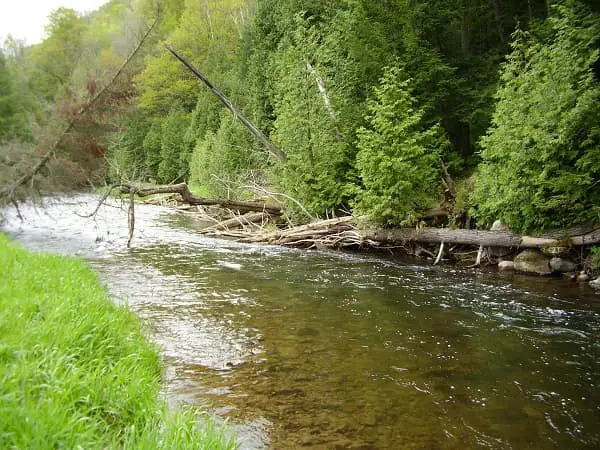
In small streams where I don’t need to cast very far, I will use lures that are much lighter and smaller. These lures won’t make a big splash in a small pool and spook the fish.
When lure fishing for steelhead in larger rivers that require much longer casts, I will go to a larger sized lure or a heavier lure that can be cast a long way.
Depth is also an important factor. If it’s really shallow water and you land a huge lure on the steelhead head or close by you can spook it. But a smaller lure in shallow water makes less of a splash and is less intrusive.
In deep water, a big splash can actually be a good thing. If a lure splashes 10 feet over their heads it makes them look, and as the lure starts to move that can trigger a chase and hit.
GUIDE TIP: This is one of my favorite tricks for getting the attention of big steelhead in deeper sections of the river. I smash the big lure on the water, twitch it once or twice to make it look like a struggling or injured bait fish, and start reeling slowly, with multiple twitches and pauses throughout the retrieve. I have found many days this works twice as well as a straight retrieve.
The Right Lure For Water Temperature
This comes back to the fish’s activity level. If the water is very cold or the water temperature has dropped fast the steelhead could be very inactive, and I find a smaller lure fished slowly will often entice the most bites from the cold steelhead.
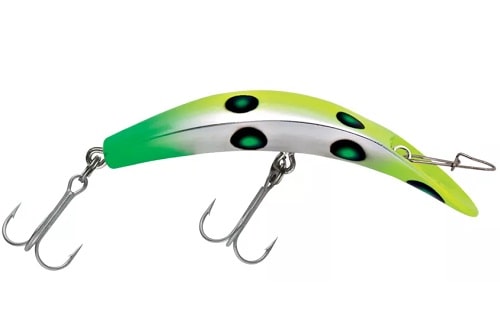
When lure fishing for steelhead in the winter a slower erratic lure will often entice the most strikes.
A great lure for this is the 2 or 3-inch Kwickfish Xtreme, or Flatfish.
In ideal water temps between 48F and 63F, the larger lures of 4 o5 5 inches are a good choices since the steelhead in these temperatures will be more active.
Match The Lure To The Bait Fish
This is a tough one because it’s often hard to determine what the natural baitfish size is but if you see a lot of small 4-inch minnows swimming around try using a 4-inch lure in a similar color.
If you see lots of bigger baitfish, then go up a size or two.
The Right Lures For Low-Light Conditions
Under low light conditions and when fishing at night, I find that larger lures will work better than smaller lures.
Lures that move slower and have some noise like a rattle or a vibration also tend to work better in low light conditions of early morning, dusk, and at night.
I also find that steelhead are often more active in low light conditions and as I said before, more active fish will hit larger lures.
Use The Right Lure Colors When Lure Fishing For Steelhead
Using the right lure colors is very important when lure fishing for steelhead because under certain conditions the steelhead will often respond better to one color versus another color.
I’d love to say that one color is best or that dark colors are the way to go, but some days they want crazy bright oranges, yellows, or chartreuse, and other days they’re all over blacks, or dark greens.
As a general rule, the most effective and consistent lure colors for steelhead are silver, gold, copper, orange, olive, and black.
However, under different light conditions and water clarity, other colors like Chartreuse, red, and pink, and combinations with silver can be good. Using colors that match the natural forage of the river is also a good idea.
Lure Fishing For Steelhead In Small Streams
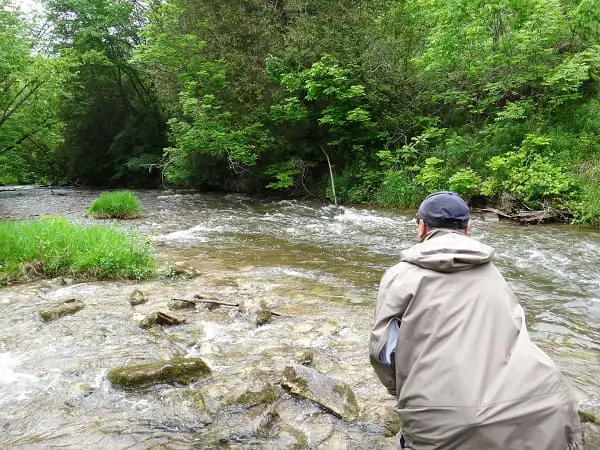
Lure fishing for steelhead in smaller streams and rivers calls for different lures and different tactics than you would use in larger rivers. Small stream lure fishing may mean one or two casts in a pool or pocket and then you move on.
Lure fishing in small rivers doesn’t require heavy lures that can be cast far, and as I previously mentioned, large lures can sometimes spook steelhead holding in smaller clear pools.
In smaller clear rivers, especially in slower currents and shallow pools, it’s best to start with smaller lures and then work your way to larger sizes.
It’s also best not to land your lure over their heads as this could spook them.
Instead cast the lures at the head of the pool in the faster water and as close to the far bank as possible, and let it swing across in front of them. In a small pool they will see it. If that doesn’t work, cast lower but cast as close to the far bank as possible and let it swing through the pool again.
The best lures to use in small rivers are spinners, spoons, and jigs but I have done well with small plugs too.
When lure fishing for steelhead in a small river you may need to change your lure based on the size of each spot. A spot that is 15 feet long and 10 feet wide can be fished with a plug that needs to be reeled in to give it some action but a spot that is 6 feet wide and 6 feet long may not be big enough for a plug but might be perfect for a jig or a spinner.
Lure Fishing For Steelhead In Larger Rivers
If you are fishing larger rivers that are 30 feet across or more, you will need to change your tactics and your lures. Lure fishing for trout in larger rivers often requires bigger lures or heavier lures that can be cast far enough to get to the fish.
You will also need lures that can get deep enough since many larger rivers are deeper. Using a 5-inch Rapala crankbait that only dives 3 to 5 feet deep may not be the best option which means you will need to find lures that can get to the desired depth.
You also need to know where the right depth is and how to get your lure there which I discuss below.
How To Fish Lures For steelhead More Effectively
I watch a lot of anglers lure fishing for steelhead with very poor technique and because of that, they miss a lot of trout.
If you are going to lure fish for steelhead, you need to know how to cover the water properly, and that means with each cast and at every depth. You also need to know how to work your lure since different lures work differently.
In order to do all of these things, you need to be standing in the right position, and you need to know how to get the lure in the strike zone.
As a guide, I’m often in a boat, so I get to pick the best spot for my clients, and that best spot is usually on one side of the river or another and is about 20 to 30 feet upriver from where the pool starts.
I don’t want to be on top of the fish, I want to be far enough away that they don’t detect us. And when lure fishing, you can cast a long way in a big river so there is no need to be close to the fish.
Cover The Water Effectively With Lures
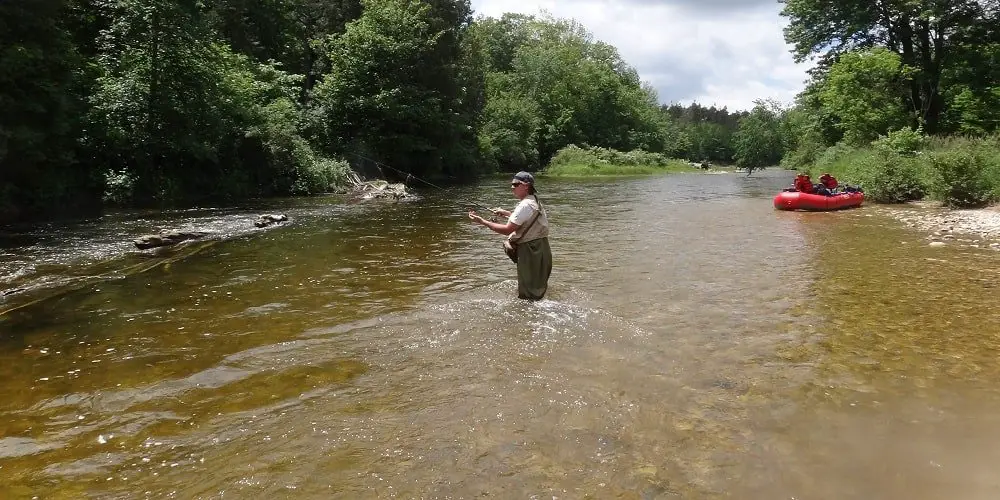
Not covering the water well, or properly, is likely the biggest mistake the average angler lure fishing for steelhead makes.
Most anglers do not systematically cover the water and will start throwing their lures aimlessly in all different directions. some will even fan cast. Guys, fan casting is for bass, off a dock!!
Casting aimlessly is a big MISTAKE and it’s the reason why a lot of anglers will go home empty-handed when lure fishing for steelhead.
To cover the water with a lure effectively you need to have your starting point and your end point in mind and make sure you cover every 3 to 5 feet of the spot you will be fishing. I DON’T MISS A SPOT!
By covering the water effectively, you ensure that every steelhead in the pool sees your lure at least once. This is important, and it’s one of the primary reasons guides and experienced anglers catch a lot more steelhead than most guys.
When lure fishing for steelhead you should almost always start casting at the top of the pool and then work your way down the pool, instead of starting at the bottom of the spot and working your way up.
Part of the reason for this is that steelhead face upriver most of the time and a lure being dragged up behind the fish might spook it. Also, it’s because a lure that is behind the fish may not be seen.
I also believe that casting upriver and retrieving means the lure is moving straight at the steelhead. This can spook them since bait fish don’t usually swim at them, they swim away from them, and a lure moving at them is coming too fast.
Also, in order to spin the blades of a spinner, or to get the right wobble on your spoon, you need to move it extra fast when retrieving in the same direction as the current. A slower moving bait, almost always gets eaten more often.
Lastly, most predatory species hit their prey from the side, bottom, or from behind. they rarely hit their prey head-on.
Therefore, fishing top-down and swinging your bait across the pool puts your lure in front of the fish, and at the right speed, and at the right angle.
The exception to this rule is fishing in low clear water with steelhead that are nervous, therefore, it may be better for you to stay behind the fish so they don’t see you and get spooked.
A spooked fish’s first instinct is to freeze, and it will go lock-jaw, and which means it won’t eat anything.
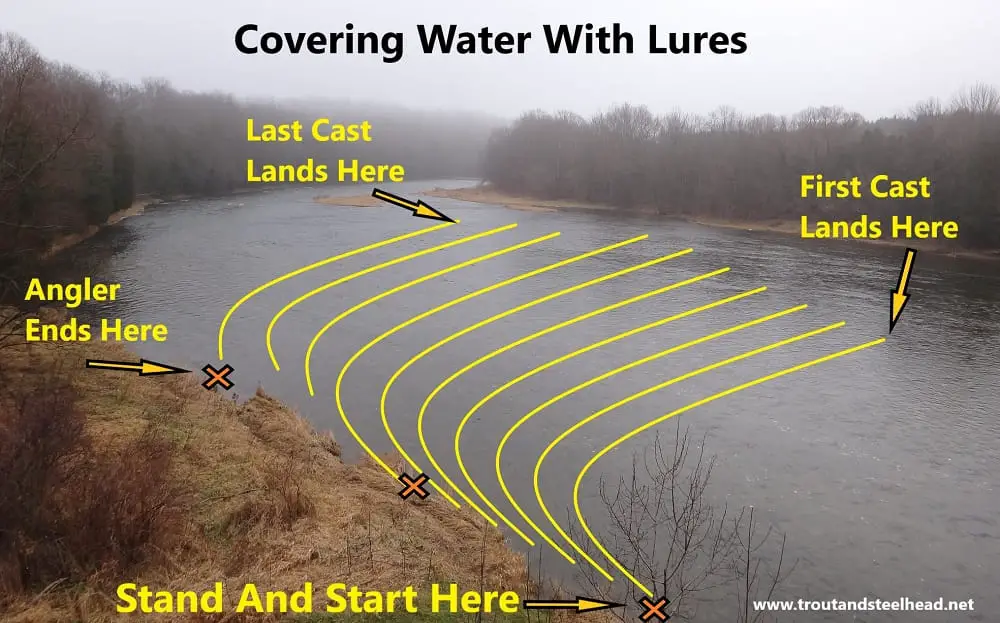
The yellow line indicates the path of the lure and where to land your lure.
The fish will usually be in the deeper parts of the pool but they can be right where the angler is standing or they could be further back or even tight to the bank if it’s deep enough like this spot is.
For this reason, each cast should land about 3 to 6 feet apart so that as the lure is retrieved (follow the path of each yellow line in the picture).
If the lure lands every 3 feet down with each consecutive cast, the lure path should be about 3 feet apart as well. In clear water, it’s not unusual for a steelhead to move up to 6 feet to grab a well-presented lure.
Casting 4 to 5 feet apart is my go-to distance when the water is clear, but when the water is dirtier, I will make each cast every 2 or 3 feet apart to be sure that I get the lure close enough to all the steelhead in the pool. The lure needs to be close enough that they can see it or sense it through their lateral line even in the dirtiest of water.
Guide Tip: A tip when lure fishing for steelhead in dirty water is to slow down, keep a straight retrieve (not side to side) and use noisy lures. Lures with a rattle or lures with a loud vibration like the Vibax Spinner and a lure traveling slowly in a straight line is easier to see and hit.
On huge rivers that are clear, I will often land my lures every 5 to 6 feet apart just to be able to cover a lot more water faster and to get my lure in front of a lot more steelhead.
You should start your casts right where the water goes from shallow into deeper water, and you end your cast where the water goes from deeper into the shallower water. This often means between the rapids or riffles.
You may think this is not important, but I have guided for over 20 years for trout, steelhead, salmon, musky, pike, bass, and walleye, and on some of these guide trips I will fish with my clients, and I have had days where I have landed 10 fish while my clients catch none.
If I told you that I always put my clients in the best spots, I always have them cast the best places, I give them the most effective lures or the exact same lure as me, and I fish the unproductive water, you would think they would catch a lot more fish than I do, but they rarely do. All I do differently is cover the water more effectively (I am meticulous about it), and I work my lure better, and it pays off!
Cover The Depth Of The Water With Your Lures
Covering the water also means that you need to cover the water at all depths, and this can be a bit tricky to do for the beginner angler.
If you use these tips below, it can really help you catch more steelhead when you fish with lures. In many rivers, we can’t see the bottom, Therefore we don’t really know how deep the spot actually is.
If we cast out a spinner or a spoon and start retrieving it right away without letting it sink ( many anglers do this), the lure may only go down 2 or 3 feet. That’s great if the spot is only 3 or 4 feet deep, but it’s bad if the spot is 8 to 12 feet deep.
Some steelhead won’t move more than a couple of feet so it’s always best if we can get the lure within 24 to 36 inches of a steelhead. Getting closer to a less aggressive steelhead increases your chances that it will grab your lure.
Therefore we have to find the bottom to make sure we are deep enough. The way I find the bottom is to use lures that run deeper like a deep-diving crankbait or plug or I will use sinking lures like a spinner.
FYI, a wide-blade spinner will run shallower than a thin-blade spinner.
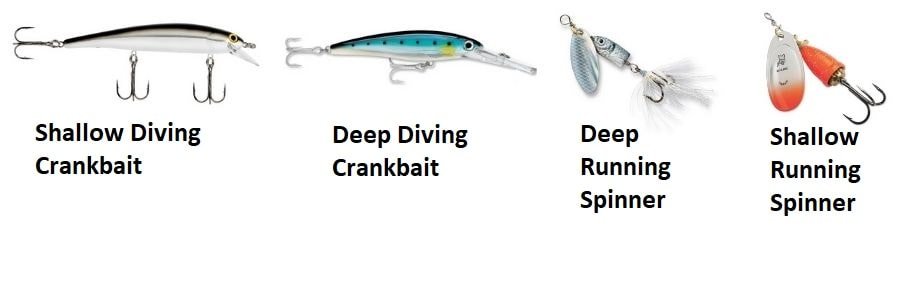
To do this, I start by casting and making a retrieve with my rod tip straight out or pointed slightly toward the water. If I don’t hit bottom on that cast, I will repeat the exact same cast, in the same spot, following the same path, but this time with my rod tip lower or even touching the water. If I don’t hit bottom I repeat again but this tip with my tip a foot or two into the water.
If I hit bottom on any cast I will lift my tip up, if it hit again partway through the cast I lift the tip even higher.
If I still do not hit bottom I will change my lure to a deep diving lure or a weighted lure like a spoon or a spinner and repeat.
If I still don’t hit bottom with these sinking lures I will cast and let the lure sink for a few seconds before I start my retrieve. If I hit bottom, I just lift my tip, and on the next cast, I won’t wait as long before I start to retrieve or I will remember where my tip was on the last cast after I lifted it.
I will repeat these steps from the top of the pool to the bottom of the pool.
Once you figure out the lure or the sink time to find the bottom all your other casts should be faster. The reason I keep trying to locate the bottom throughout the pool is that the top of the pool where the rapids come in might be 3 feet deep, but 10 feet downriver from that spot it might be 7 or 8 feet deep.
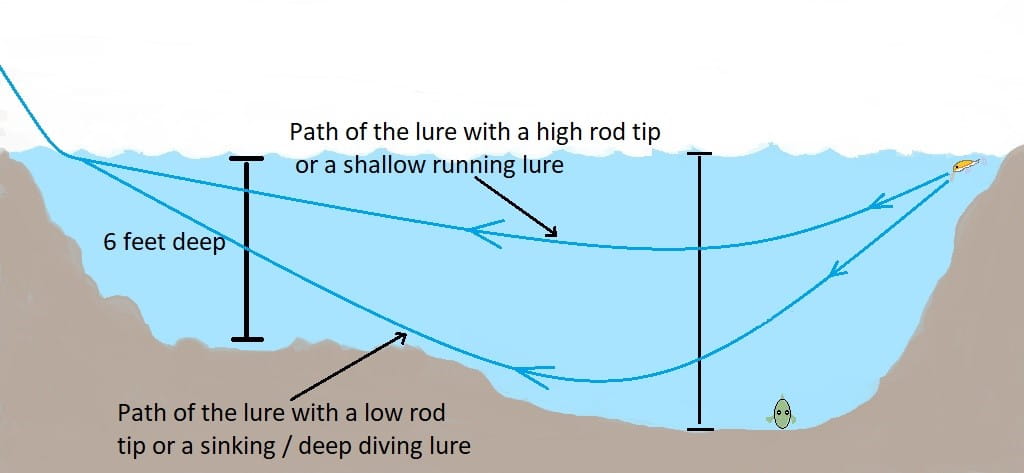
It’s also not uncommon for one side of the pool to be deeper than the other like in the picture so pay attention to where in the retrieve you keep hitting the bottom.
Once you hit bottom or if there is a high spot that you keep hitting, simply lift your tip high enough to raise the bait up and off the bottom at that point. You want to keep your bait about 12 to 24 inches off the bottom, or 36 inches at the very least.
If you get good at covering the water systematically and you get good at finding the bottom and then lifting the lure up and hovering it just off the bottom you can greatly increase the amount of fish you can catch. When I say greatly increase the amount, I’d bet it’s close to 10 times more fish. As I said before, there are reasons why guides catch more fish, and covering the water is HUGE!
Lures that drag the bottom will get hung up often, and you will likely catch fewer fish so don’t drag the bottom unless you want to lose a lot of lures. Bumping the bottom occasionally is OK.
See the best spinners and spoons at:
Work Your Lure For More Steelhead
The last tip I will give you when lure fishing for trout is to work your lure.
The difference between a professional bass angler using a crankbait and a rookie angler using a crankbait is more than just the amount of fish they both catch. Yes, the bass guy will usually catch way more bass even if they are both using the same lure simply because the pros work their lures better.
Most anglers think that you just cast, and then retrieve a lure and that is how it’s done.
A lure that is cast out and then reeled straight in will catch fish, sometimes, but a lure that is cast out and worked properly will catch far more fish. I and other guides, pro anglers, and tournament anglers have proven this over and over again.
Often, the difference between a great angler and an average angler is how much effort they put into working the lure.
I have taught many anglers how to do this well, and it always catches more steelhead. Steelhead, salmon, trout as well as other predatory fish have a harder time resisting a dying, struggling, or injured baitfish.
So, if you reel your lure straight in, it looks healthy and fast and might get away, so it’s a harder target, for the fish, especially less aggressive fish. But if you jerk-it, rip-it, twitch-it, and then pause it, then it looks injured, and this is harder for even a neutral active fish to resist.
A dying wounded baitfish action triggers a strike response even in less active fish. The more erratic, the better sometimes, it’s almost like they can’t resist it.
Even with spinners and spoons, I will reel it in 5 to 10 feet and then rip or jig it with a split-second pause between rips and pause again to trigger a strike. Try it, it works!
Best Lines For Lure Fishing For Steelhead
There are four types of lines that could be used when lure fishing for steelhead. Your options are Monofilament, Copolymer, fluorocarbon, and Braid.
Everyone has an opinion or a preference, but based on my experience this is what I recommend.
Multipurpose Line
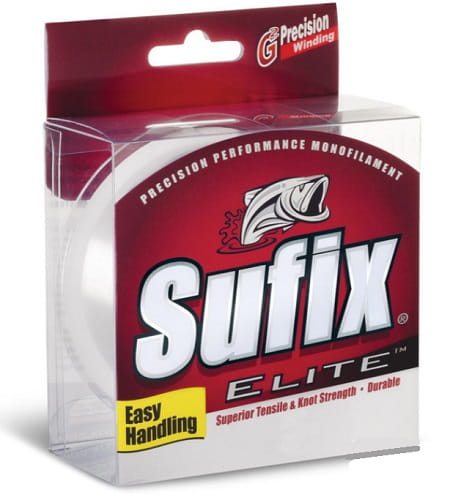
If you are a newer angler or an occasional fisherman that wants to cast lures, then switch and do some float fishing, or you might want to do drift fishing or bottom bouncing, go with a monofilament line like 10 to 12-pound Sufix Elite for great lakes steelhead, or use 12 to 14 pound for West Coast Steelhead or when fishing big rivers.
I do not like fluorocarbon or copolymer lines if you are going to do any float fishing.
If you are a frequent or more experienced angler, use a 20 to 30-pound braided line for all methods.
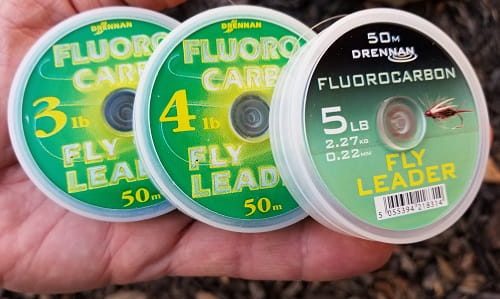
When casting lures with a braided line add a 12 to 17-pound, 16″ to 24″ fluorocarbon leader like Drennan 6 pound, or 10 pound Seaguar STS Steelhead Leader. I attach my leader with a quality 2-way swivel like the SPRO Power Swivels.
If you are going to float fish use my float fishing leader setup.
Lure Fishing Only Line
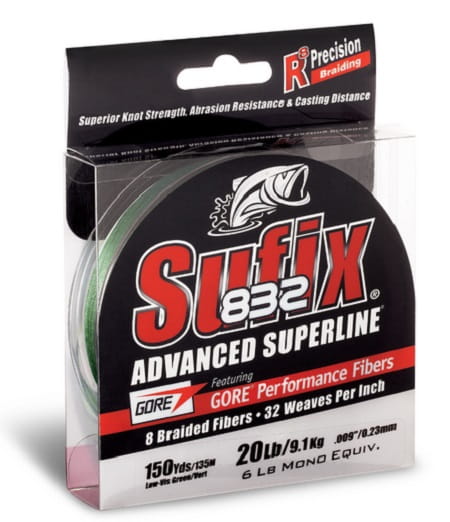
Braid is likely the best line for anglers that just want to cast lures.
It is very thin which helps it cut through the water to get the lure deeper and to stay deeper. It also has no stretch so the hook sets are solid.
Braid is also a much thinner diameter and therefore you can get a lot more on the spool which is a bonus when those giant steelhead make 300-foot runs.
New users to braid may find some rod tip wrapping more often but with practice and some adjustments, this should happen less.
A good braid that I have used for 20 years is Berkley FireLine Thermally Fused Superline or PowerPro Braided Spectra Fiber Microfilament Line and recently I really like the Sufix 832 braid.
Fluorocarbon lines are also a good choice for casting lures. Fluorocarbon is less visible to the fish, it tends to sink so that helps keep the lure down, and it is very abrasion resistant so it’s good when fishing around a lot of rocks.
Caution: Cheap fluorocarbon lines suck! They tangle, twist, and can jump off the spool whenever you give it any slack. Therefore, buy only top of the line fluorocarbon lines that are proven to work well on spinning reels or baitcasting reels. I recommend lines like 12 or 15 pound Seaguar InvizX Fluorocarbon Line.
Attaching The Lure
There are a few ways that are best to attach your lure to your mainline or your leader.
I mention above about using a 16 to 24-inch fluorocarbon leader of 12 to 14-pound test, or 16 pounds when fishing west coast steelhead or very large rivers. I attach the leader using a quality swivel. This is for braided lines, however, I do this will all types of lines.
The reason is that Fluorocarbon is less visible to the fish, it is also abrasion resistant which can help prevent break-offs from nicks, scraps, and cuts from rocks.
Attach the lure to the leader or to the mainline using a standard knot like an Improved Clinch Knot. You can tie the mainline directly to the lure. In-line lures that spin like a Mepps Spinners can cause some serious line twists which can weaken the line. I generally only tie mono or fluorocarbon direct to crankbaits or plugs like the Kickfish.
The other option is to use a loop knot. Loop knots are supposed to give the lure more freedom to move and create more action. A simple and strong knot like the Kreh Loop Knot works well with lures and is the one I use.
The last method and the one I use the most is a good snap swivel. I say “good” because there are some really weak and crappy ones available that will open and bend when fighting big steelhead and salmon. Consider a good snap like the Offshore Angler Ball Bearing Swivel with Coastlock Snap
Don’t Forget Your Steelhead River Gear
It’s important that you have all the right gear when fishing on rivers for steelhead. The right gear will help you get to the fish, stay comfortable and dry, and will help you manage and land your steelhead.
For a full list of gear for river fishing that I use and recommend, check out my page on The Best River Gear.
Ask A Guide About Lure Fishing For Steelhead
Anyone that knows me knows I love to teach and guide for steelhead with many methods including steelhead fishing with lures. If you have a question about lure fishing for steelhead or if there are some tips you have that you want to share, let me and my reader know in the comment section below.
Tight Lines
Graham
